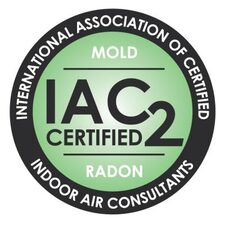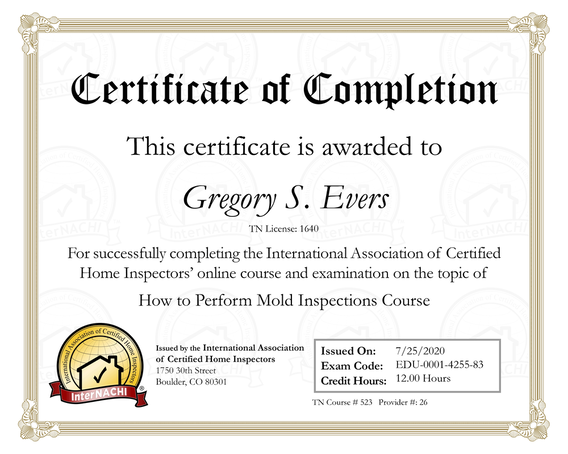Mold Testing Services in Johnson City, Kingsport & Bristol, TN as well as other areas.
What Is The Difference Between Mold & Mildew Growing Inside My House?
Mold is a type of fungus that produces growth on various types of moist or decaying surfaces. It can grow on leather, clothing, walls, ceilings, and all building materials almost anywhere that moisture is present. While some mold is harmless, some can be toxic mold and cause health problems in both humans and animals.
Mildew is also a type of fungus that grows on moist surfaces. However, mildew is generally found in showers and bathtubs. Although mildewing surfaces are not toxic, they can cause problems for people who are allergic to mold.
Why is mold growing in my home?
Molds are part of the natural environment. Outdoors, molds play a part in nature by breaking down dead organic matter such as fallen leaves and dead trees, but indoors, mold growth should be avoided. Molds reproduce by means of tiny spores; the spores are invisible to the naked eye and float through outdoor and indoor air. Mold may begin growing indoors when mold spores land on surfaces that are wet. There are many types of mold, and none of them will grow without water or moisture.
Can mold cause health problems?
Molds can become a problem indoors, when mold spores land on a wet or damp spot and begin growing. Molds have the potential to cause health problems. Molds produce allergens, irritants, and in some cases, potentially toxic substances.
Allergic reactions to mold are common and include hay fever-type symptoms, such as sneezing, runny nose, red eyes, and skin rash. Molds can also cause asthma attacks in people with asthma who are allergic to mold.
How can I determine if mold is in my home?
Mold spores will not grow without water or moisture. Identifying areas of moisture are key to preventing mold growth inside of your home. Our state-of-the-art infrared thermal imaging technology provides a visual footprint of moisture within the walls and ceiling of your home by detecting the wet areas. Many times these areas go unseen because they are invisible to the naked eye. The combination of this technology with the use of moisture meters, visual inspection and mold testing equipment provide the latest advancements in testing procedures.
What to do if you suspect that your home has mold?
• You can allow Tri Summit Home Inspections to conveniently bundle your MOLD Inspection with our Home Inspection. Our company will test for mold and issue a report usually within 24 hours of the inspection. We handle all the details.
• How does Tri Summit Home Inspections fit into this process? When Tri Summit Home Inspections inspects your home, we always look for indications of fungal growth. If found, we indicate these findings in our home inspection report. This information is good to know even if your bank does not require a mold testing. Our findings do not constitute a a positive indication of mold growth. These findings just let you know that we think you should take the next step.
Get a Mold Assessment of your home from Tri Summit Home Inspections, LLC - a certified mold inspector, prior to performing any mold cleanup and remediation.
Surveying the moisture levels of walls, ceilings and floors, determining relative indoor humidity levels, locating visible and non-visible mold growth, and testing the indoor air quality for the quantity and variety of mold spores can provide valuable information during the assessment of your home and its indoor air quality. Determining the variety of mold is important because some types of mold are indicators of water damage and potential health problems.
Performing a thorough mold assessment and testing can save thousands of dollars in un-required mold remediation in areas of your home that may not have a mold problem. Mold spores are usually too small to see with the naked eye, until the spores begin fruiting and growing in large numbers on a building surface. This is why only performing a visual inspection of a home is not enough to determine if their is a problem with the indoor air quality. Testing the air along with a visual inspection is the only way to determine if and where there is a problem inside the home.
Indoor Air Sampling
It is primarily these samples that determine airborne mold spore counts. Proximate outdoor air is also tested (for the control sample) For reliable results, the equipment used includes a controlled volume air pump, which draws air through a spore trap cassette.
After the samples have been performed they are shipped FedEx overnight to an accredited microbiology laboratory for microscopic examination and analysis. Typical turnaround is about 24 hours.
Mold Testing in the Tri Cities, TN
Contact us today to have your home independently tested for mold and elevated moisture conditions
(423)737-2733
For more information, read the EPA's A Brief Guide to Mold, Moisture, and Your Home.
The above information is provided as a public service by the Environmental Protection Agency for educational purposes.
What Is The Difference Between Mold & Mildew Growing Inside My House?
Mold is a type of fungus that produces growth on various types of moist or decaying surfaces. It can grow on leather, clothing, walls, ceilings, and all building materials almost anywhere that moisture is present. While some mold is harmless, some can be toxic mold and cause health problems in both humans and animals.
Mildew is also a type of fungus that grows on moist surfaces. However, mildew is generally found in showers and bathtubs. Although mildewing surfaces are not toxic, they can cause problems for people who are allergic to mold.
Why is mold growing in my home?
Molds are part of the natural environment. Outdoors, molds play a part in nature by breaking down dead organic matter such as fallen leaves and dead trees, but indoors, mold growth should be avoided. Molds reproduce by means of tiny spores; the spores are invisible to the naked eye and float through outdoor and indoor air. Mold may begin growing indoors when mold spores land on surfaces that are wet. There are many types of mold, and none of them will grow without water or moisture.
Can mold cause health problems?
Molds can become a problem indoors, when mold spores land on a wet or damp spot and begin growing. Molds have the potential to cause health problems. Molds produce allergens, irritants, and in some cases, potentially toxic substances.
Allergic reactions to mold are common and include hay fever-type symptoms, such as sneezing, runny nose, red eyes, and skin rash. Molds can also cause asthma attacks in people with asthma who are allergic to mold.
How can I determine if mold is in my home?
Mold spores will not grow without water or moisture. Identifying areas of moisture are key to preventing mold growth inside of your home. Our state-of-the-art infrared thermal imaging technology provides a visual footprint of moisture within the walls and ceiling of your home by detecting the wet areas. Many times these areas go unseen because they are invisible to the naked eye. The combination of this technology with the use of moisture meters, visual inspection and mold testing equipment provide the latest advancements in testing procedures.
What to do if you suspect that your home has mold?
• You can allow Tri Summit Home Inspections to conveniently bundle your MOLD Inspection with our Home Inspection. Our company will test for mold and issue a report usually within 24 hours of the inspection. We handle all the details.
• How does Tri Summit Home Inspections fit into this process? When Tri Summit Home Inspections inspects your home, we always look for indications of fungal growth. If found, we indicate these findings in our home inspection report. This information is good to know even if your bank does not require a mold testing. Our findings do not constitute a a positive indication of mold growth. These findings just let you know that we think you should take the next step.
Get a Mold Assessment of your home from Tri Summit Home Inspections, LLC - a certified mold inspector, prior to performing any mold cleanup and remediation.
Surveying the moisture levels of walls, ceilings and floors, determining relative indoor humidity levels, locating visible and non-visible mold growth, and testing the indoor air quality for the quantity and variety of mold spores can provide valuable information during the assessment of your home and its indoor air quality. Determining the variety of mold is important because some types of mold are indicators of water damage and potential health problems.
Performing a thorough mold assessment and testing can save thousands of dollars in un-required mold remediation in areas of your home that may not have a mold problem. Mold spores are usually too small to see with the naked eye, until the spores begin fruiting and growing in large numbers on a building surface. This is why only performing a visual inspection of a home is not enough to determine if their is a problem with the indoor air quality. Testing the air along with a visual inspection is the only way to determine if and where there is a problem inside the home.
Indoor Air Sampling
It is primarily these samples that determine airborne mold spore counts. Proximate outdoor air is also tested (for the control sample) For reliable results, the equipment used includes a controlled volume air pump, which draws air through a spore trap cassette.
After the samples have been performed they are shipped FedEx overnight to an accredited microbiology laboratory for microscopic examination and analysis. Typical turnaround is about 24 hours.
Mold Testing in the Tri Cities, TN
Contact us today to have your home independently tested for mold and elevated moisture conditions
(423)737-2733
For more information, read the EPA's A Brief Guide to Mold, Moisture, and Your Home.
The above information is provided as a public service by the Environmental Protection Agency for educational purposes.


